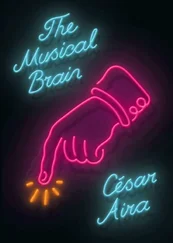Although he knew this to be absurd, he could not help imagining that were he to find himself in a robbers’ cave, for example, among the most brutal of criminals, he would be able to avoid violence if he behaved reasonably, talking and listening to others’ opinions and expressing his own. Even if the situation was ripe for violence, even if the robbers had caught him spying. . But how could they have caught him if he himself had not planned his intrusion? And he had sworn he’d never again get himself into an awkward situation like that. It’s true that he could have entered that hypothetical cave by mistake, thinking it was empty and unoccupied; that’s where paying attention came into play — that he should always be awake, never blink. Which was easier said than done, though to achieve it, he had a practice, an ascesis, which he had made his life plan. Even so, a miraculous incident could occur in which he suddenly opened his eyes and found himself in a cave full of stolen goods, and before he had time to react a gang of suspicious-looking subjects entered. . Of course, he was smack in the middle of the realm of the imaginary, of remote possibilities. Once he was there with them, what would prevent him from establishing a civilized conversation with the robbers, getting them to understand what had happened, the teleporting, the somnambulism. .? But in that case the robbers would also be part of the fiction, the theory, and his persuasive success would have no demonstrative value. Real reality was comprised of blood and blows and shouts and the slamming of doors. In the long run, the glaze of courtesy got scratched, if not from the causal line of facts then from another, inevitably, from the line that emerged out of the bifurcation of time.
An enormous dog lying at the entrance to an auto repair shop stood up when it saw him then bared its teeth. He instantaneously broke out in a cold sweat. What an incredible lack of consideration on the part of the owners of these animals, leaving them loose on the sidewalk and responding to any complaint with the familiar, “He’s friendly, he won’t do anything.” They say it with total sincerity, and full conviction, but they haven’t stopped to think that nobody else has any reason to share that conviction, much less so when facing a black mantle the size of a motorbike hurtling toward them. .
His first encounter with the world of paranormal medicine had been through dogs. When he was a child in the town of Coronel Pringles, Mayor Uthurralt issued an order mercilessly expelling all of them from the city limits, without exception or appeal. Fear alone (it was the era of the terrible polio epidemic) guaranteed compliance, this in spite of the usually strong attachment between pets and their owners. Moreover, the expulsion was temporary, though it ended up lasting three years, and nobody had to really get rid of their pets: all they had to do was find a place for them somewhere in the countryside. In a town that lived off rural activities, everybody had a friend or relative with a plot of land nearby, and that’s where the dogs were sent. The problem was that the only veterinarian in Pringles was separated from his patients, and although he accepted having to travel to treat them (he had no choice if he wanted to keep working), the process was expensive and bothersome. And it made it difficult to neuter male puppies when they reached reproductive age, operations that had become that much more urgent under the present circumstances. Faced with the truly ghastly alternative of handing them over to farm hands, who could carry out the brutal procedure only with a branding iron and without any sterilization, some doled out a lot of money, others shut their eyes, most hesitated. . It was an opportunity for a local photographer, nicknamed the Madman, to start a business of long-distance, painless neutering, which became all the rage in Pringles during that period. Dr. Aira, at the time a child of eight, heard of this through rumors that had been grossly distorted in the echo chamber of his childhood circle. At that time, such subjects were rarely discussed, especially in a decent middle-class family; his little friends, all from poor families because he lived in a neighborhood of hovels, did not suffer from this disadvantage, but their families’ amazing ignorance and credulity fully compensated for this lack.
The Madman’s method was of exemplary absurdity, for it consisted of a fairly long series of penicillin shots given to the dogs’ owners, shots that neutered the animal in absentia. At least that’s what could be garnered from the stories that were making the rounds. He could never find out anything more, and perhaps there was nothing more. Nor did he ever learn in any reliable way if anyone had actually agreed to submit to this strange treatment. But this information was enough for him to reinvent on his own the possibility of action from a distance, of discontinuous efficiency, one that created a new continuum out of heterogeneous elements, and from then on his entire mental landscape was based on this premise. Soon thereafter the Madman’s method ceased to be used (if it ever had been in reality), this in the wake of a scandal of vast proportions. A headless dog was born on a nearby farm, a cocker spaniel whose body stopped at his neck but who nevertheless survived and even grew to adulthood.
Inevitably, popular imagination connected one thing to the other, and the Madman, perhaps also frightened by the effects of his manipulations, threw in the towel, for the time being. Dr. Aira didn’t know what ever happened to that dog; at some point it must have died, like any other dog. Many people in the town went to see it (it hadn’t been sent away). Apparently, the animal was very lively: hyperactive as well as acephalous. Its nervous system ended in a bulb on top of its neck, and this protuberance, like a Rosetta stone, was covered with markings that represented eyes, nose, mouth, and ears, scribbles it made do with. Under other circumstances the fact that such a monster was viable would have attracted the attention of scientists all around the world; it should have been considered a kind of miracle. But country folks are accustomed to such miracles — paradoxically, they used to be more accustomed to them, back then when they lived in greater isolation, without radio or television or magazines; their entire world was the small world they lived in, and their laws made room for exceptions and extensions, as a totality always does.
If this had happened with a dog, why couldn’t it happen with a man? This possibility, the infinite and infinitely fantastic possibility, established the always so immediate limitations of reason. All that polite reasoning he planned to use with the robbers in the cave showed itself to be just one form, a form contiguous with life’s many violent insanities. Reason is one mode of action, nothing more, and it has no special privileges. The fact that he had extended its reach to cover everything, like a panacea he hoped would make up for the shortcomings of action, was simply a personal quirk, and a very symptomatic one: it showed his true colors and the error in which he lived. Because those eminently reasonable characters he so much admired and whom he modeled himself after (like Mariano Grondona), were considered reasonable only pour la galerie — that’s how they made their living — but they also had a real life in which they were not reasonable, or they were only intermittently and carelessly so, depending on the circumstances, as these things should be. In order for action to be effective, one had to depart from the purely reasonable, which would always be an abstract way of thinking devoid of any truly practical use.
One could depart through realism. Realism was obviously a representation, but precisely for this reason it could become a spontaneous way of being when applied to an entire discourse. Realism was a deviation from the reasonable; a theory pointed to a path that was a straight line, but the realistic man who knew how to live followed one that was roundabout and had twists and turns. . each one of these detours away from the straight path was by nature and intention Evil. It didn’t matter that it was an attenuated Evil, one without consequences; its essence was still Evil, and it had to be for the detour to be effective and for realism to be created, and for reality to be seen through realism, finally, real reality, so distinct from the pale fantasies of reason. . Perhaps there, in that eminently benevolent utility, resided Evil’s purpose.
Читать дальше












